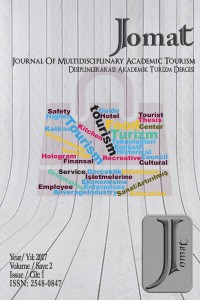Tarihi Yapıların Turizm Amaçlı Kullanılması: Karatay Medresesi Örneği
Abstract
Türkiye coğrafyası
geçmişte birçok medeniyete ev sahipliği yapmış olması sebebiyle önemli bir
kültürel ve tarihi mirası barındırmaktadır. Oldukça dikkatli korunmaya
çalışılan bu miras, mimari eserleri de kapsamaktadır. Tarihi yapılar, çoğu
şehirde farklı işlevlerle kullanılmaktadır. Bazıları restoran ve otel gibi
sosyal amaçlı dönüşüm geçirirken, bazıları müze işleviyle ziyaretçilere açılmaktadır.
Karatay Medresesi, Selçuklu İmparatorluğu döneminde inşa edilmiş ve başkent
olan Konya’ya değer katmıştır. Tarihsel süreçte önemi büyük olan medrese,
günümüzde çini eserleri müzesi olarak kullanılmakta ve ziyaretçileri kabul
etmektedir. Bu çalışmada, Karatay Medresesi’nin tarihsel süreçteki değişimi ve
müzeye dönüştürüldükten sonra kullanımı anlatılmıştır. Ayrıca yıllara göre ziyaretçi
sayıları da analiz edilmiştir. Konya’daki kültür turizmine önemli katkıları
olduğu saptanmıştır.
Keywords
References
- McKercher, B., and Du Cros, H. (2002), Cultural tourism: The Partnership Between Tourism And Cultural Heritage Management, Routledge.
- Atçeken, Z. (1998), Konya’daki Selçuklu Yapılarının Osmanlı Devrinde Bakımı ve Kullanılması, Türk Tarih Kurumu Yayınları, Ankara.
- Erdemir, Y. (2001), Karatay Medresesi Çini Eserleri Müzesi, T.C. Konya Valiliği İl Müdürlüğü, Konya.
- Richards. G. and Munsters, W. (2010), Cultural Tourism Research Methods, AMA Dataset, Preston: UK.
- Öztürk, Y. and Yazıcıoğlu, İ. (2002), “Gelişmekte Olan Ülkeler İçin Alternatif Turizm Faaliyetleri Üzerine Teorik Bir Çalışma”, Ticaret ve Turizm Eğitim Fakültesi Dergisi, Volume 2, Ankara.
- Kızılırmak, İ. and Kurtuldu, H. (2005), “Kültürel Turizmin Önemi ve Tüketici Tercihlerinin Belirlenmesine Yönelik Bir Çalışma”, Ticaret ve Turizm Eğitim Fakültesi Dergisi, Volume 1, Ankara.
- Sheldon, P. (1991), “An Authorship Analysis Of Tourism Research”, Annals of Tourism Research 18, pp.473–484.
- Yaldız, E. (2001), “Konya’daki Medrese Yapılarının Yeniden Kullanım Koşullarına Göre Değerlendirilmesi” Master Thesis, Selçuk University.
- Admin (2014), Konya Karatay Medresesi, Nerededir? Nasıl Gidilir?, http://www.camilerveturbeler.com/turbeler/karatay-medresesi-nerededir-nasil-gidilir.html, [Accessed 7.05.2017]
- http://www.kulturvarliklari.gov.tr/TR,43336/muze-istatistikleri.html, [Accessed 21.08.2017]
The Use Of Historical Buildings For Touristic Purposes: The Case Of Karatay Madrasah
Abstract
Since Turkey has hosted many civilizations in the past,
it has an important cultural and historical heritage. This heritage, which is
tried to be kept very careful, includes also architectural works. These
historical buildings are often used with different functions. While some of
them have a social transformation such as restaurants and hotels, some of them
are open to visitors with the function of the museum. The Karatay Madrasah was
built during the Seljuk Empire period and added value to the capital, Konya.
The madrasah, which is important in the historical process, is to use museum of
tile works and accept visitors today. In this study, Karatay Madrasah was
explained about the change in the historical process and its use after
conversion to the museum, also number of visits by years. It has been
determined that it is an important contribution to cultural tourism in Konya.
References
- McKercher, B., and Du Cros, H. (2002), Cultural tourism: The Partnership Between Tourism And Cultural Heritage Management, Routledge.
- Atçeken, Z. (1998), Konya’daki Selçuklu Yapılarının Osmanlı Devrinde Bakımı ve Kullanılması, Türk Tarih Kurumu Yayınları, Ankara.
- Erdemir, Y. (2001), Karatay Medresesi Çini Eserleri Müzesi, T.C. Konya Valiliği İl Müdürlüğü, Konya.
- Richards. G. and Munsters, W. (2010), Cultural Tourism Research Methods, AMA Dataset, Preston: UK.
- Öztürk, Y. and Yazıcıoğlu, İ. (2002), “Gelişmekte Olan Ülkeler İçin Alternatif Turizm Faaliyetleri Üzerine Teorik Bir Çalışma”, Ticaret ve Turizm Eğitim Fakültesi Dergisi, Volume 2, Ankara.
- Kızılırmak, İ. and Kurtuldu, H. (2005), “Kültürel Turizmin Önemi ve Tüketici Tercihlerinin Belirlenmesine Yönelik Bir Çalışma”, Ticaret ve Turizm Eğitim Fakültesi Dergisi, Volume 1, Ankara.
- Sheldon, P. (1991), “An Authorship Analysis Of Tourism Research”, Annals of Tourism Research 18, pp.473–484.
- Yaldız, E. (2001), “Konya’daki Medrese Yapılarının Yeniden Kullanım Koşullarına Göre Değerlendirilmesi” Master Thesis, Selçuk University.
- Admin (2014), Konya Karatay Medresesi, Nerededir? Nasıl Gidilir?, http://www.camilerveturbeler.com/turbeler/karatay-medresesi-nerededir-nasil-gidilir.html, [Accessed 7.05.2017]
- http://www.kulturvarliklari.gov.tr/TR,43336/muze-istatistikleri.html, [Accessed 21.08.2017]
Details
| Primary Language | English |
|---|---|
| Subjects | Tourism (Other) |
| Other ID | https://www.jomat.org/75-2017-2-1/157-2017-2-1-39-46 |
| Journal Section | Research Papers |
| Authors | |
| Publication Date | November 21, 2017 |
| Acceptance Date | November 21, 2017 |
| Published in Issue | Year 2017 Volume: 2 Issue: 1 |


